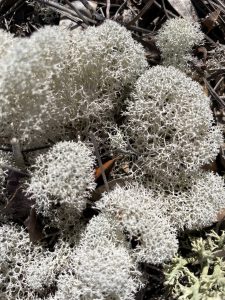
Always a pale gray-green amidst a forest full of browns and dark greens, deer moss stands out not just for its color, but its interesting shape and texture. It really looks more like a sponge than anything else. Also known as reindeer moss and reindeer lichen (Cladonia spp.), it is correctly categorized as a lichen—an organism formed by a mutualistic relationship between blue-green algae and fungus. In deer moss, the blue-green algae photosynthesizes and produces food, while the fungus serves as a skeleton and support for the algae.
Lichens come in several categories based on structure; foliose (leafy or lettuce-like), crustose (low-growing on trees or rocks), or fruticose (branched or bushy). Based on its growth habit, deer moss is considered a fruticose lichen.

Deer moss is a groundcover with no roots that basically sits atop the soil. This makes it an easily accessible nesting material for birds. It grows slowly, typically topping out at 4 inches tall.
Deer moss typically grows in the sandy soil of wooded upland habitats throughout the southeastern United States and as far north as the Arctic tundra. Deer—especially reindeer—eat the lichen, perhaps making it the primary reason for the common name and association. The lichens are not particularly filling, but do provide important carbohydrates.
Source: UF/IFAS Pest Alert
Note: All images and contents are the property of UF/IFAS.



